Standard [CURRENT]
ASTM B 1025:2025
Standard Specification for Electrodeposited Nanostructured Zinc-Nickel Coatings
- Publication date
- 2025
- Original language
- English
- Pages
- 11
- Publication date
- 2025
- Original language
- English
- Pages
- 11
- DOI
- https://dx.doi.org/10.1520/B1025-25
Product information on this site:
Quick delivery via download or delivery service
Buy securely with a credit card or pay upon receipt of invoice
All transactions are encrypted
Short description
1.1 This specification covers requirements for electrodeposited nanostructured zinc-nickel alloy coatings. The coatings can be applied to iron and steel, as well as other substrates, such as stainless steel and aluminum bronze, when an appropriate barrier coating is used. 1.2 The coatings are intended to provide corrosion protection to oil and gas, automotive, and aerospace components such as fasteners, brackets, and housings. The coatings may also be used in other industrial applications in which enhanced corrosion resistance is desired. 1.3 The coatings provide durability and corrosion resistance in diverse challenging environments, ranging from atmospheric exposures with variable humidity, offshore and marine settings subjected to saline conditions, to scenarios with fluctuating temperatures and potential chemical interactions found in automotive and aerospace applications. Note 1: Nanostructured zinc-nickel alloy coatings exhibit superior corrosion resistance due to their ultrafine grain size in the nanometer (10-9 m) range. In addition to the nanoscale grains, the unique non-porous laminar microstructure (that is, layers or banding observed after chemical etching) also contributes to this enhanced protection. The ultrafine/nanocrystalline grains, with their higher specific grain boundary surface area, increase galvanic electrochemical activity, leading to an enhanced passivation response. This heightened passivation helps in forming a more stable and protective oxide layer on the surface, further mitigating corrosion. Simultaneously, the non-porous layered microstructure acts to increase corrosion resistance and overall durability, while allowing for hydrogen relief. As a result, nanostructured zinc-nickel coatings enhance the galvanic/barrier properties compared to standard continuous DC electrodeposited zinc-nickel coatings. Validation of the nanostructured nature of these coatings is achieved through a combination of microstructure evaluation, corrosion testing, and open circuit potential (OCP) periodic testing, ensuring the effectiveness of the processing methods. Note 2: Nanostructured ultrafine grain sizes are obtained using adjustments to the DC electrodeposition process, including modifications to the applied current, specific bath chemistries, bath temperature, and other parameters. Detailed methods can be found in Appendix X1 . 1.4 Units- The values stated in SI units are to be regarded as the standard. No other units of measurement are included in this standard. 1.5 This standard does not purport to address all of the safety concerns, if any, associated with its use. It is the responsibility of the user of this standard to establish appropriate safety, health, and environmental practices and determine the applicability of regulatory limitations prior to use. 1.6 This standard has been revised to comply with the Restriction of Hazardous Substances (RoHS) Requirements that seek to limit the exposure of workers and the public to toxic metals. The alloy does not contain any of the six restricted hazardous substances. 1.7 This international standard was developed in accordance with internationally recognized principles on standardization established in the Decision on Principles for the Development of International Standards, Guides and Recommendations issued by the World Trade Organization Technical Barriers to Trade (TBT) Committee.
ICS
25.220.40
DOI
https://dx.doi.org/10.1520/B1025-25
Also available in
Loading recommended items...
Loading recommended items...
Loading recommended items...

